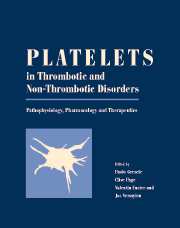Book contents
- Frontmatter
- Contents
- List of contributors
- Editors' preface
- PART I PHYSIOLOGY
- PART II METHODOLOGY
- PART III PATHOLOGY
- 34 Hereditary thrombocytopenias
- 35 Thrombocytopenias due to bone marrow disorders
- 36 Immune-mediated thrombocytopenia
- 37 Thrombocytopenia in childhood
- 38 Alloimmune thrombocytopenia
- 39 Drug-induced and drug-dependent immune thrombocytopenias
- 40 Thrombotic thrombocytopenic purpura and hemolytic uremic syndrome
- 41 Thrombocytosis and thrombocythemia
- 42 Platelet adhesive protein defect disorders
- 43 Congenital disorders of platelet secretion
- 44 Congenital platelet signal transduction defects
- 45 Acquired platelet function defects
- 46 Platelet storage and transfusion
- 47 Pathophysiology of arterial thrombosis
- 48 Platelets and atherosclerosis
- 49 Platelet involvement in venous thrombosis and pulmonary embolism
- 50 Gene regulation of platelet function
- 51 Platelets and bacterial infections
- 52 Interactions of viruses and platelets and the inactivation of viruses in platelet concentrates prepared for transfusion
- 53 Platelets and parasites
- 54 Platelets and tumours
- 55 Platelets and renal diseases
- 56 Platelets and allergic diseases
- 57 Platelet interactions with other cells related to inflammatory diseases
- 58 Platelets and the preimplantation stage of embryo development
- 59 Platelets in psychiatric and neurological disorders
- 60 Platelets in inflammatory bowel disease
- PART IV PHARMOLOGY
- PART V THERAPY
- Afterword: Platelets: a personal story
- Index
- Plate section
40 - Thrombotic thrombocytopenic purpura and hemolytic uremic syndrome
from PART III - PATHOLOGY
Published online by Cambridge University Press: 10 May 2010
- Frontmatter
- Contents
- List of contributors
- Editors' preface
- PART I PHYSIOLOGY
- PART II METHODOLOGY
- PART III PATHOLOGY
- 34 Hereditary thrombocytopenias
- 35 Thrombocytopenias due to bone marrow disorders
- 36 Immune-mediated thrombocytopenia
- 37 Thrombocytopenia in childhood
- 38 Alloimmune thrombocytopenia
- 39 Drug-induced and drug-dependent immune thrombocytopenias
- 40 Thrombotic thrombocytopenic purpura and hemolytic uremic syndrome
- 41 Thrombocytosis and thrombocythemia
- 42 Platelet adhesive protein defect disorders
- 43 Congenital disorders of platelet secretion
- 44 Congenital platelet signal transduction defects
- 45 Acquired platelet function defects
- 46 Platelet storage and transfusion
- 47 Pathophysiology of arterial thrombosis
- 48 Platelets and atherosclerosis
- 49 Platelet involvement in venous thrombosis and pulmonary embolism
- 50 Gene regulation of platelet function
- 51 Platelets and bacterial infections
- 52 Interactions of viruses and platelets and the inactivation of viruses in platelet concentrates prepared for transfusion
- 53 Platelets and parasites
- 54 Platelets and tumours
- 55 Platelets and renal diseases
- 56 Platelets and allergic diseases
- 57 Platelet interactions with other cells related to inflammatory diseases
- 58 Platelets and the preimplantation stage of embryo development
- 59 Platelets in psychiatric and neurological disorders
- 60 Platelets in inflammatory bowel disease
- PART IV PHARMOLOGY
- PART V THERAPY
- Afterword: Platelets: a personal story
- Index
- Plate section
Summary
Introduction
Thrombotic thrombocytopenic purpura (TTP) is a disseminated form of thrombotic microangiopathy that was initially described by Moschowitz in 1924 as a new disease. He reported an abrupt onset of petechiae, anemia and microscopic hematuria in a 16-year-old girl, who presented with fever and malaise and died 13 days later. He observed widespread hyaline microthrombi in the terminal arterioles and capillaries and interpreted them as agglutinated and hyalinized erythrocytes caused by ‘a powerful poison which had both agglutinative and hemolytic properties’. A congenital form of TTP was reported by Schulman et al., who suggested that the pathogenesis was due to deficiency of a platelet-stimulating factor in the patient's plasma. A similar congenital deficiency of a plasma factor, important in platelet and red-cell survival, was later described by Schulman in another patient with chronic relapsing TTP. Familial predisposition to TTP was implicated from observations of siblings suffering from recurrent TTP. The congenital form of TTP has been occasionally described in the literature as Upshaw–Schulman syndrome.
TTP is characterized by the pentad of severe thrombocytopenia, microangiopathic hemolysis with erythrocyte fragmentation, neurologic deficit, renal dysfunction, and fever. A TTP-like disorder, the hemolytic uremic syndrome (HUS), usually occurs in children, and is characterized by the triad of thrombocytopenia, microangiopathic hemolytic anemia and renal dysfunction. The diagnosis of TTP is usually made in adult patients with neurologic dysfunction, whereas children with predominant glomerular damage are preferably diagnosed as having HUS.
- Type
- Chapter
- Information
- Platelets in Thrombotic and Non-Thrombotic DisordersPathophysiology, Pharmacology and Therapeutics, pp. 610 - 622Publisher: Cambridge University PressPrint publication year: 2002



